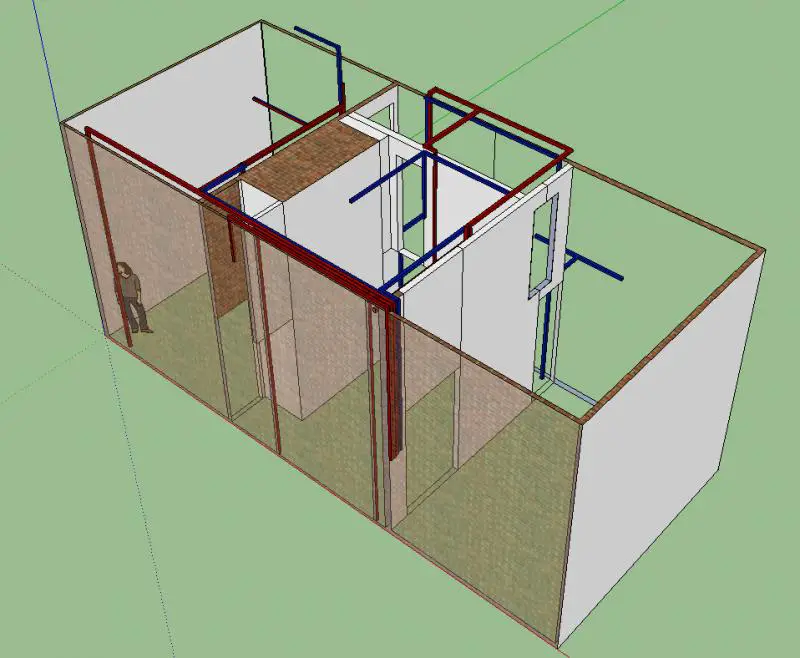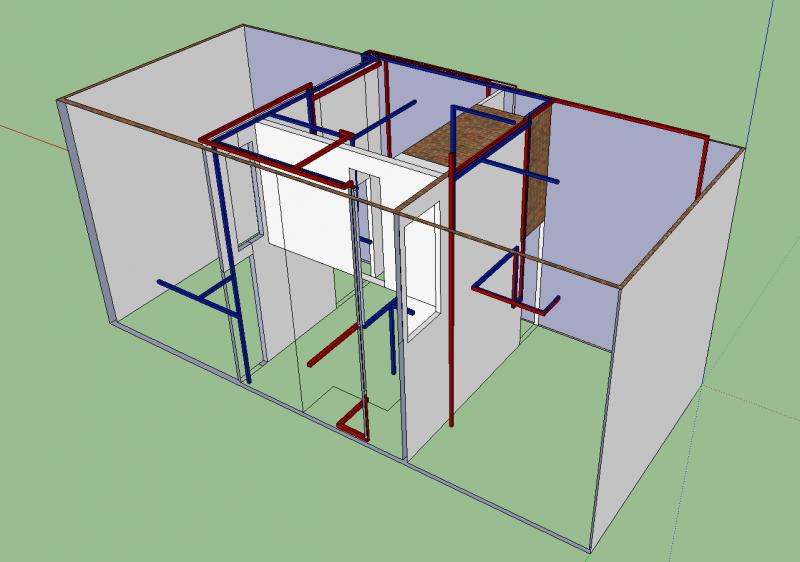Hello Friends!
Disclaimer: I realise I'm probably putting myself up for receiving a bit of flack for undertaking a complete rewire whilst asking what some of you might deem to be stupid questions. All I can say is I haven't got a choice, I'd like to do this as safely as possible, hence coming here to ask for and gratefully receiving your help. Please treat me as if I haven’t got a choice and that I’m doing the best with what I’ve got rather than that I’m making a stupid decision.
Background: We bought an old house with pre-existing shockingly bad DIY electrics. The walls have no cavities, the floors/ceilings have no cavities, some of the ceilings have wooden beams. (“Character property” they called it)
I’ve designed a new wiring layout which I think will leave very few exposed/visible wires, and so far in studying BS7671:2008 will comply with regulations. I’ve done a 3D model in Sketchup. I’ve also read up and am complying with Part P of the building regulations for a DIY electrical installer.
The basics of the design is that I’m taking all of the cables up into the loft and then dropping down two floors. This means sockets at the front of the house in the bedroom and sockets directly below in the lounge room will be on the same circuit, and likewise sockets at the back of the house in both lounge and bedroom will be on a separate circuit/fuse.
I’ve bought a Makita chasing tool with a 3kw vacuum - on a test chase it’s doing an extremely good job of removing dust and cutting nice clean chases. So dust won’t be a concern.
I have a few initial questions:
What is the recommended maximum total length of a 2.5mm ring main circuit? Likewise for a 1.5mm lighting circuit. I’ve found it difficult to pin down a figure but it looks to be around 78-80m?
Am I ok to have sockets on different floors on the same fuse/circuit?
Am I ok to have sockets in one room on two different circuits?
I do plan to create a zone diagram for in the CU which very clearly shows which sockets/lights are on which circuits.
The final step will be to have a professional electrician install a new consumer unit and test my work.
Thank you all for your time and your help.
Andy
Disclaimer: I realise I'm probably putting myself up for receiving a bit of flack for undertaking a complete rewire whilst asking what some of you might deem to be stupid questions. All I can say is I haven't got a choice, I'd like to do this as safely as possible, hence coming here to ask for and gratefully receiving your help. Please treat me as if I haven’t got a choice and that I’m doing the best with what I’ve got rather than that I’m making a stupid decision.
Background: We bought an old house with pre-existing shockingly bad DIY electrics. The walls have no cavities, the floors/ceilings have no cavities, some of the ceilings have wooden beams. (“Character property” they called it)
I’ve designed a new wiring layout which I think will leave very few exposed/visible wires, and so far in studying BS7671:2008 will comply with regulations. I’ve done a 3D model in Sketchup. I’ve also read up and am complying with Part P of the building regulations for a DIY electrical installer.
The basics of the design is that I’m taking all of the cables up into the loft and then dropping down two floors. This means sockets at the front of the house in the bedroom and sockets directly below in the lounge room will be on the same circuit, and likewise sockets at the back of the house in both lounge and bedroom will be on a separate circuit/fuse.
I’ve bought a Makita chasing tool with a 3kw vacuum - on a test chase it’s doing an extremely good job of removing dust and cutting nice clean chases. So dust won’t be a concern.
I have a few initial questions:
What is the recommended maximum total length of a 2.5mm ring main circuit? Likewise for a 1.5mm lighting circuit. I’ve found it difficult to pin down a figure but it looks to be around 78-80m?
Am I ok to have sockets on different floors on the same fuse/circuit?
Am I ok to have sockets in one room on two different circuits?
I do plan to create a zone diagram for in the CU which very clearly shows which sockets/lights are on which circuits.
The final step will be to have a professional electrician install a new consumer unit and test my work.
Thank you all for your time and your help.
Andy



